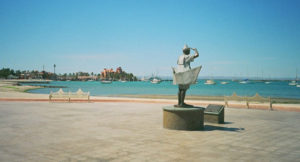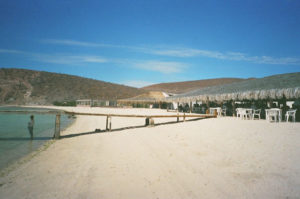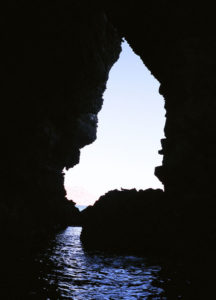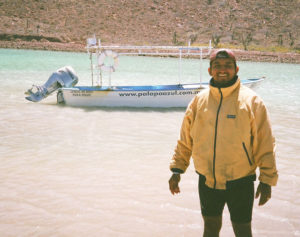Our trip started with the idea that we had not been to Mexico for a while, so it was time to get our Mexico fix. Our plan was a one week get away to a Mexican beach, using our frequent flier miles. The airline reservation desk was somewhat confused when we told them that we wanted to go to a Mexican beach, any Mexican beach, and that we were very flexible about dates. We ended up with plane tickets to the San Jose del Cabo airport, near the southern tip of the Baja. Rather than stay in the Los Cabos resort area, we decided to go to La Paz, which we had never seen.
La Paz is about three hours from the San Jose del Cabo airport. We elected not to rent a car. When we landed, we took a taxi to the bus terminal, and then a three hour bus ride on a luxury bus to La Paz. We were able to get the front seats opposite the driver, the best seats for sightseeing. We saw a lot of desert and some of the beaches on our bus ride. From the bus station on the malecon, we took a short taxi ride to the Hotel Mediterraneo, near the center of town and just a few steps from the water.
La Paz is a pleasant, tranquil Mexican city that happens to be on the water. Although tourism is an important local industry, it is not a resort city like Cancun or Puerto Vallarta. We often remarked on the courtesy of the drivers, who always stopped to let us cross the street. We found the people relaxed, polite and helpful.
La Paz is on the gulf side of the Baja California peninsula, about 100 miles (150 km) from the southern tip of the Baja. La Paz is the capital of the state of Baja California Sur, and has a population of about 150,000 people. Baja California Sur is one of the fastest growing states in Mexico, and La Paz is not exempt from this growth. There are several housing developments going up, some targeting tourists, some aimed at locals.
The city is built on a large natural harbor, and is a popular stop for sailors, with several marinas. As a boater myself, I enjoyed kayaking in the marinas and chatting with some of the boat owners and sailors. La Paz does not have white sand beaches in town, although there are some beautiful beaches north of town. What La Paz has is the malecon, a wide concrete walkway along the waterfront, complete with sculptures. The malecon is a popular place to stroll, for locals and tourists, with an unobstructed view of the bay. The malecon is punctuated by a large pier or muelle that extends out into the bay from the center of town. There is a beach road, the Paseo Álvaro Obregón, on the city side of the malecon. The town is surprisingly hilly in some areas, with some challenging sidewalks, although this will not be an issue on the malecon or in the main business districts.
The history of La Paz goes back to Hernan Cortez, who founded a settlement there in 1535. However, it was soon abandoned. Several other attempts also failed. The city we see was finally founded in 1811. In the early 20th century, La Paz was a major pearl producer. However this ended around world war II, when an unknown disease devastated the oysters. The pearling tradition lives on primarily in the names of businesses, which have names like “La Perla de La Paz”.
The climate of La Paz is warm in the winter, with highs in the 70s, and hot in the summer, with highs in the 90’s. We found the weather warm and pleasant.
Transportation
You can arrive in La Paz by air, by bus, by ferry, by personal vehicle, or by private boat.
La Paz has an airport with many flights going to California. An alternative is to fly to San Jose del Cabo, and then drive or take a bus to La Paz. You may be able to fly to San Jose del Cabo more cheaply than to La Paz, and perhaps with fewer connections. I suggest that you look at flights to both airports before you make your decision.
Like most Mexican cities, La Paz is served by several bus lines. The main bus station is relatively new, and conveniently located on the malecon, near the center of town. The luxury line is called Peninsula Ejecutivo. It is a true luxury line, with wide seats, two on one side and one on the other, like the ETN bus line. We recommend Peninsula if you have a choice. ABC bus line, Autobuses Baja California, is a Plus line, a little above first class. Aguilar is a first class line with relatively modern buses. ABC and Aguilar go as far as Tijuana. The ATP line has a separate bus terminal at Delgolado and Guelermos Prieta streets, with service to the south of La Paz. I judge ATP to be between first class and second class, although they call it first class.
There are two highway routes from La Paz to San Jose del Cabo, the via corta (short route) that goes along the pacific, and the via larga (long route), which takes a seemingly direct route inland. If you look at the map, the via corta looks like the long way, so the terminology is somewhat confusing. We were told that the travel time to San Jose del Cabo was about the same for both routes. However, if you are going to Todos Santos or Cabo San Lucas, you need to take the via corta. We took the via corta, the Pacific route, since that is the route of the luxury bus line, and cannot report on the via larga.
The ferry terminal is called Pichilingue, about 10 miles (17 km) north of La Paz, with service three times a week to Mazatlan and Topolobampo (Los Mochis). When we were there, the ferry to Topolobampo was out of service for maintenance, but scheduled to be back in service in a few weeks. TMC runs the ferry to Mazatlan, and Baja Ferries to Topolobampo.
The main roads in the Baja are now paved, but tend to be somewhat narrow and twisty. The general rule to avoid night driving in Mexico certainly applies in the Baja. La Paz is 1000 miles (1500 km) from Tijuana and the border with California.
Hotels
The top hotel in town is Los Arcos, with room rates around $100 US. It is located on the Malecon, There are two sections to this large hotel. One section is a conventional hotel, with rooms around a courtyard with a pool. The other section is the Cabanas, little buildings set in a small jungle. I liked the feel of the jungle, but the cabana rooms seemed dark to me.
We stayed at the Hotel Mediterrane, with only 9 rooms, and room rates around $70 US. It is well run by a couple of Swiss gentlemen. It is located on Allende street, just a few steps from the malecon. The refrigerator was convenient, and I enjoyed using their free kayaks to get out in the bay, get some exercise, and look at boats. The free computer set up for guests made it easy to check our email. Our room with a view, Santorini, had more street noise than we would like. It might make sense to get a room tucked back away from the street noise, and give up the view.
One budget alternative is the Hotel Lorimar, a block from the malecon on Nicolas Bravo street. The room rates are between $20 and $40 US. We met a couple who were staying there, and they described it as basic, but reasonable.
Note that there are some resort hotels away from the center of town, or even up the coast, but we prefer to stay closer to the center of town. If you had a car, then it would not be so inconvenient to be outside of town.
Restaurants
We tried a number of restaurants during our stay, but most of them were forgettable.
The best food that we found was the restaurant La Pazta, part of the Hotel Mediterraneo. It is not inexpensive, but consistently good, with an European menu.
Los Pargo restaurant is inexpensive and popular with locals. It is a large modern restaurant with a Mexican menu. You can find it on Calle Revolution near Reforma, not far from the Cathedral.
The Bismark or Bismark-cito was recommended to us, but we cannot recommend it. We both became quite ill with food poisoning a few hours after ordering the same shrimp dinner there.
There are at least two good coffee shops in town, as reported by my personal coffee taster, my spouse. The coffee shop Esquisito is on the malecon between the dock (muelle) and the Burger King. The 5th Avenida Cafe is on 5 de mayo, near the Cathedral. It looks like a Starbucks, and offers internet service.
Ice cream is always good in a hot climate, and we found a couple of good ice cream stores. La Fuente is a family business on the Malecon near the tower at the muelle, conveniently marked with a tree painted with polka-dots. Gelatos is on Allende between Revolution and Francisco Madero. Gelatos is run by a very personable young man, who is happy to let you taste samples.
Attractions
The Museo Regional de Antropología e Historia is good, including information on geology, native peoples, and history of Baja California Sur. We recommend it, even if you don’t read Spanish.
There is a very small museum devoted to whales. The museum was not very interesting, but the whale skeleton outside the museum was impressive. This museum is near the city theatre.
We did not make it to the Serpentarium, but we saw a small preview in a storefront on the malecon. If you want to see live snakes and other reptiles behind glass, you will not be disappointed.
Beaches
Although there are some beaches in town next to the malecon, the nice beaches in the La Paz area are mostly some distance north of town. There are a whole series of beautiful beaches with names like Playa Pichilingue and Playa Tecolote, 17 km or more from La Paz. Most of these beaches have a palapa restaurant to get a cold drink out of the sun. However, these beaches are relatively inconvenient to reach if you do not have a car. There are a few buses a day that leave from the bus station on the Malecon. If you have come to La Paz primarily for the beaches, you have probably come to the wrong place.
Shopping
The central business district is around calle 16 de Septiembre, starting at the malecon and going inland for several blocks.
The new shopping center is a huge shopping mall, anchored by a large Soriana department store. It includes a big supermarket, movie theaters, and many other stores. The buses that go there have “Soriana” in big letters on the windshield, you can pick them up a few blocks inland from the Malecon, south of calle 16 de Septiembre. The bus fare is a few pesos.
If you walk along the malecon, on the sidewalk away from the beach, you will find many businesses oriented to tourists, including wood carvings and many other crafts.
We found a couple of good bookstores in town. The Conaculta bookstore has a wide selection of books and magazines about Mexico in Spanish. It is located on 16 de Septiembre near Ignacio Zaragoza. Another bookstore, redundantly named “Libros Libros Books Books” is located at Constitution and Madero. Despite the name, it carries only a small number of books and magazines in English.
Tours
When we inquired about possible day tours, there were two main options, whale watching and Isla Espiritus Sanctus. During the January through March whale watching season, you can take a tour to see the whales for about $100 US. This is a very long day that starts with a two hour drive to get to Magdalena bay where the whales can be seen. We spoke to some tourists who loved it, loved being so close to the whales.

Todos Santos
The town of Todos Santos is located between La Paz and Los Cabos, on the Pacific side. It was once the prosperous sugar cane capital of the Baja, but that ended around World War II. The city was almost a ghost town in the 1950s. Paved roads did not reach Todos Santos until the 1980s. It has become a fashionable art community, with many resident artists from north of the border. Since it was discovered, real estate, construction, tourism, art, and crafts have become the local industries. We took a bus and spent the day there.
The Centro Cultural Professor Néstor Agúndez is worth a visit. I was fascinated by the old photographs from the sugar cane era. One of the local institutions is the Hotel California, where we had lunch. This is a four star hotel, with some outrageously overdone decor, reputed to be the hotel on which the Eagles song of the same name was based.
Wandering through the many galleries and shops, we saw beautiful paintings that we could not afford, and affordable unique art and crafts at the XOMO gallery, and the Agua y Sol Bazaar. Most of the many craft stores seem to carry the same crafts, so if you have seen one you have seen them all. We ended up buying a copper pot hammered out in the Santa Clara del Cobre tradition from XOMO gallery. The owner has family connections to Santa Clara, and will do custom copperwork.
The town of Todos Santos is set back a little from the ocean. The large waves coming in across the Pacific make the surfing good, and swimming dangerous.
Summing up La Paz
La Paz is a pleasant place to spend a few days in a real Mexican town on the water. In the six full days that we had in La Paz, we took in most of the usual tourist activities, but were hardly out of things to do. If you want to relax in a laid back Mexican port city, La Paz is a good place to go.

















